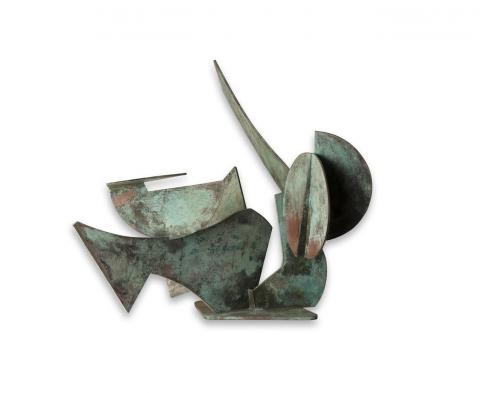SHOUTING ANGELS, 1994
INGE KING
bronze
85.0 x 95.0 x 118.0 cm
signed and dated on base: Inge King 94
Australian Galleries, Sydney
The Estate of the late James O. Fairfax AC, Sydney, acquired from the above in 1999
Recent Sculpture by Inge King, Australian Galleries, Sydney, 8 April 1999 – 1 May 1999, cat. 5
Singing Child, 1993, bronze, 82.0 x 41.0 x 68.0 cm, illus. in Trimble, J., Inge King Sculptor, Art and Australia and Craftsman House, Sydney, 1996, p. 164
Unfolding laterally in space like a flower, the forms of Inge King’s Shouting Angels,1994 are caught in an eternal tussle. A dynamic example of her refined series of ‘angel’ compositions, this work displays the verve and maturity of composition that characterised the late figurative works of the doyenne of Australian sculpture. Classically trained in the United Kingdom and Germany, King became a pre-eminent figure in the development of non-objective art in Australia, not only encouraging the application of a modernist aesthetic within the sculptural practice of her adoptive home, but also lobbying to integrate sculpture within the urban environment.
Following on from the exuberant figurative works of 1992 and 1993, which translated balletic and gymnastic movement into static and planar forms, the works of King’s ‘angel series’ had simplified compositions, smoother outlines and a more marked spiritual presence. Assembled from disjointed and intersecting planes of sheet metal, Shouting Angels is at once a three-dimensional mass and a collage of flat surfaces assembled across dimensions. Rearticulating the interaction between the volume of a sculpture and the space around it, King’s works integrate negative space within their forms, rather than simply displacing it, creating sculptures that suggest a thousand different angles of vision. Graeme Sturgeon, eminent curator and scholar of Australian sculpture, wrote of the seductive and tantalising appeal of King’s sculptures: ‘we are denied any sense of formal predictability, the complexity of the relationship, and the distinctiveness of different views, mean that the work eludes our intellectual grasp, constantly renewing out interest as we move about it’.1
The late James O. Fairfax responded to the tense and balanced composition of Shouting Angels, displaying it on a pedestal in the gardens of his weekend home at Bilgola in Sydney’s northern beaches. In this environment, while the curved forms of the sculpture stretched out towards the horizon, the briny breeze created a pale green patina and the work carries this Verdigris surface proudly. The constantly evolving nature of outdoor sculpture was something that King enjoyed, declaring in 2006: ‘Multidimensional objects look different from every angle. The exciting thing about outdoor sculpture is the change with the light, the weather ... everything is in constant flux. It becomes almost a living entity’.2
Suspended in a tense opposite movement, the geometric forms that compose each of the angels’ figures are unapologetic and bold. Shouting Angels features clearer and more pronounced curved shapes than the earlier Joie De Vivre sculptures, inspired by Paul Klee’s schematic figuration as opposed to the gestural formalism of Matisse’s cut-outs that had fed into King’s earlier works. The disjunctive planes suggesting discord rather than the introspective humility of other works in the series, Shouting Angels illustrates King’s longstanding intention to visually translate the exquisite problems of human existence.
1. Sturgeon, G., ‘Inge King. An Obdurate Certainty’, Art and Australia, Sydney, vol. 51, no. 4, winter 2014, p. 533
2. The artist quoted in Stanhope, Z., ‘Playing Seriously’, Artlink, issue 26:4, December 2006, accessed online 31 October 2017
LUCIE REEVES-SMITH
